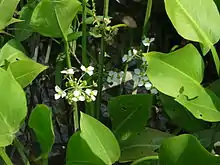Sagittaria platyphylla
Sagittaria platyphylla, the delta arrowhead,[2] broad-leaf arrowhead or delta duck-potato, is a plant species native to the eastern United States. The core of its range extends from central Texas to the Florida Panhandle north to southern Illinois.
| Sagittaria platyphylla | |
|---|---|
 | |
| Scientific classification | |
| Kingdom: | Plantae |
| Clade: | Tracheophytes |
| Clade: | Angiosperms |
| Clade: | Monocots |
| Order: | Alismatales |
| Family: | Alismataceae |
| Genus: | Sagittaria |
| Species: | S. platyphylla |
| Binomial name | |
| Sagittaria platyphylla (Engelm.) J.G. Sm. | |
| Synonyms[1] | |
| |
As an ornamental it has also been spread to other locations.[3] Isolated populations have been reported from Washington state, Missouri, Kansas, Ohio, Kentucky, Pennsylvania, West Virginia, eastern Virginia, North and South Carolina and eastern Georgia, Nuevo León, Michoacán and Panamá. It has also become a noxious weed in Australia.[4] On August 6 2015 S. platyphylla was found for the first time in China, specifically in the Yangtze River Basin. This detection was in an irrigation ditch in Zhangjiashai, Wuhan, Hubei, PRC. Other detections have continued through at least 2019 demonstrating its establishment in provinces of the middle and lower Yangtze. It presents a significant threat to the ecology and economy of the Yangtze area, especially to agricultural irrigation.[3]
Morphology
The plant is an emergent aquatic found in ponds, lakes and slow-moving streams.[5][6][7] Sagittaria platyphylla is a perennial herb up to 150 centimetres (59 in) tall, producing underground corms (similar to tubers). The plant reproduces by means of stolons as well as seeds. Some leaves are totally submerged, others emergent (raising above the surface of the water). Submerged leaves have flattened petioles but no true blades. Emergent leaves have ovate to elliptical blades up to 17 centimetres (7 in) long. Inflorescence is a raceme with 3-9 whorls of flowers. Flowers are white, up to 2 centimetres (3⁄4 in) in diameter. [5][8][9][10][11][12][13][14][15]
References
- Tropicos
- "Sagittaria platyphylla". Natural Resources Conservation Service PLANTS Database. USDA. Retrieved 26 October 2015.
- Wang, Hui; Xiao, Keyan; Wu, Zhigang; Chen, Jianfeng; Xiong, Wen; Wang, Zhengxiang; Wang, Qiang; Zhu, Hong; Bowler, Peter (2020). "Delta arrowhead (Sagittaria platyphylla) in the Yangtze River: an invasive aquatic plant and the potential ecological consequences" (PDF). BioInvasions Records. Regional Euro-Asian Biological Invasions Centre Oy (REABIC). 9 (3): 618–626. doi:10.3391/bir.2020.9.3.17. ISSN 2242-1300.
- Australian Weeds Committee, Weed Identification Guide, Sagittaria platyphylla Archived 2014-03-10 at the Wayback Machine
- "Sagittaria platyphylla in Flora of North America @ efloras.org". www.efloras.org. Retrieved 2017-01-30.
- BONAP (Biota of North America Project) floristic synthesis, Sagittaria platyphylla
- Correa A., M.D., C. Galdames & M. Stapf. 2004. Catálogo de las Plantas Vasculares de Panamá 1–599. Smithsonian Tropical Research Institute, Panama.
- Smith, Jared Gage. 1894. North American Species of Sagittaria and Lophotocarpus 29.
- Asa, Gray (1867-01-01). "Manual of the botany of the northern United States". Cite journal requires
|journal=(help) - "Image". www.tropicos.org. Retrieved 2017-01-30.
- Haynes, R. R. & L.B. Holm-Nielsen. 1994. The Alismataceae. Flora Neotropica 64: 1–112.
- Czerepanov, S. K. 1981. Sosudistye Rasteniia SSSR 509 pages. Nauka, Leningradskoe Otd-nie, Leningrad.
- Correll, D. S. & M. C. Johnston. 1970. Manual of the Vascular Plants of Texas i–xv, 1–1881. The University of Texas at Dallas, Richardson
- Wunderlin, R. P. 1998. Guide to the Vascular Plants of Florida i–x, 1–806. University Press of Florida, Gainesville.
- Godfrey, R. K. & J. W. Wooten. 1979. Aquatic and Wetland Plants of Southeastern United States Monocotyledons 1–712. The University of Georgia Press, Athens